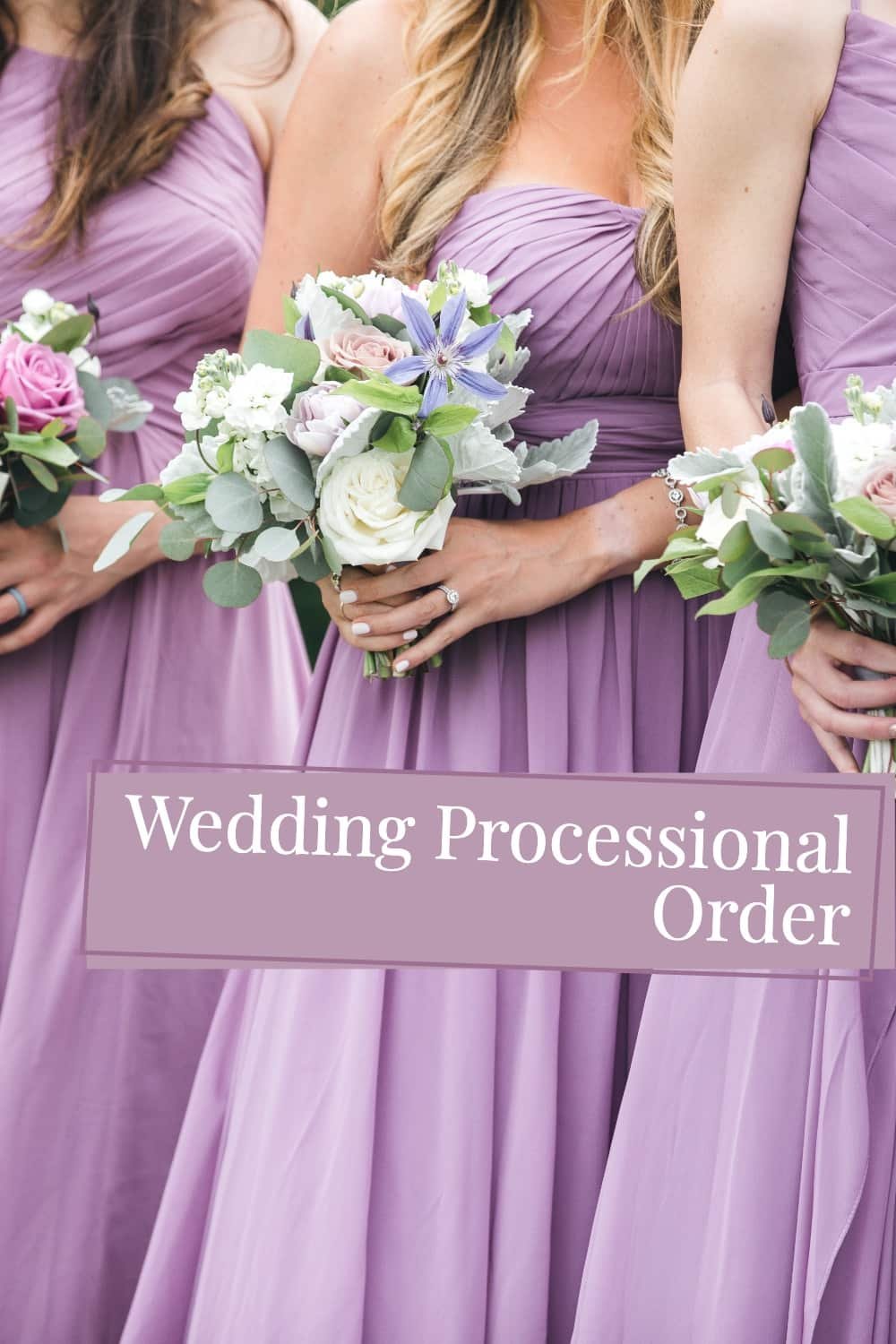How to Plan Your Wedding Processional Order
As you start planning your ceremony, you might be wondering who walks down the aisle in the wedding processional order? There’s actually a lot of different ways to get your bridal party down the aisle.
If you’re planning your wedding at a place of worship, there might be an order that you’ll need to follow. If your ceremony is at a non denominational or non traditional venue, you can plan the processional any way you’d like.
Please note: this article contains affiliate links. That means that I may earn a commission if you decide to buy something.
Wedding Processional Order For a Non Denominational Ceremony
If you’re planning a non denominational ceremony, you can plan the processional any way that you’d like. Most couples start by deciding how you’d like to enter. Some grooms want to walk down the aisle, while others would rather stand at the front. Other couples want to walk into the ceremony together.
Once you’ve decided how you’d like to enter, think about your bridal party. Most of your bridesmaids and groomsmen aren’t couples, but it can look nice to have them walk together. If you like the look and everyone is comfortable, the bridal party can walk down in pairs.
If you’ve got an uneven bridal party, another option is to send them down the aisle in groups of three. Or you could have the groomsmen standing at the front, with the groom. Each bridesmaid can walk up on their own.
If you’re having a flower girl and ring bearer, they can walk together. If they’re nervous, you could pair them with a bridesmaid or groomsman, to help them down the aisle.
In most traditional ceremonies, the parents are included in the processional. If you’ve got a good relationship and you want your parents to walk the aisle, choose the way that makes you, and them feel the most comfortable.
Some couples like to have both their parents escort them down the aisle. Others prefer to have the parents walk as part of the bridal party.
Your officiant can walk the aisle as a way to signal the beginning of the ceremony. Or you can have them waiting at the front.
With a non denominational ceremony, begin with a typical order, then rearrange it to suit your bridal party and your preferences:
The officiant.
Parents of the groom.
Parents of the bride.
The bridal party, in singles, pairs or groups.
The best man and maid of honor, single or together.
The flower girl and ring bearer.
The couple.
Wedding Processional Order For a Traditional Christian Ceremony
The traditional order for a wedding processional in a Christian wedding starts with the mother of the bride. The groom and the bridal party will follow. If there’s flower girls or ring bearers, they’ll go next. Last, the bride is escorted down the aisle by her father.
In Christian ceremonies, the groom, his family, groomsmen and guests will have their places on the right side of the church. The bride, her family, bridesmaids and guests will be on the left side of the church.
Mother of the bride.
The groom.
The best man.
The groomsmen.
The bridesmaids.
The maid or matron of honor.
The flower girl and ring bearer.
The bride with her father.
Wedding Processional Order For a Traditional Jewish Ceremony
The traditional order for a wedding processional in a Jewish wedding starts with the rabbi or the cantor taking their places, under the chuppah. The brides grandparents, then the grooms grandparents will walk down the aisle next.
After the grandparents are seated, the groomsmen, the best man and the groom will follow. Next come the bridesmaids, the maid or matron of honor. Followed by the flower girl and ring bearer.
Last to enter is the bride, escorted by her parents. Traditionally, her father will be on her left arm, her mother on her right.
In Jewish ceremonies, the groom, his family, groomsmen and guests will take their places on the left side of the temple. The bride, her family, bridesmaids and guests will be on the right side of the temple.
The rabbi or cantor.
Grandparents of the bride.
Grandparents of the groom.
The groomsmen.
The best man.
The groom.
The bridesmaids.
Maid or matron of honor.
Flower girl and ring bearer.
The bride with her parents.
Wedding Processional Order For a Traditional Hindu Ceremony
A traditional Hindu ceremony begins with a much bigger entrance. The groom arrives on a white horse, accompanied by his family and friends. This entrance is called a Baraat and it signals the beginning of the ceremony.
The bride’s family waits for the groom’s party to arrive. They’ll exchange gifts and flowers before heading the mandap, or the Hindu arch.
Next to enter is the bride, along with her bridal party, the rest of her family and her friends. Once the bride arrives at the mandap, she’ll exchange flower garlands with the groom. After the flower exchange, the wedding ceremony will begin.
Bridesmaids at a church wedding.
How Long Will the Processional Take?
The length of the processional depends on the size of your bridal party and the length of your aisle. At a traditional venue, the aisle usually begins at the doorway and ends at an altar, chuppah or other ceremonial spot. A procession like this will usually take less than 5 minutes.
Planning a Processional For an Outdoor Wedding
If your ceremony is at a non traditional venue, your aisle might not be typical. For example, if your ceremony is outdoors, your procession might begin a longer way off. If you’ll be walking across a lawn or a beach before you reach the beginning of the aisle, your procession will take longer.
If your guests have to wait while each person walks the entire way, it could take a while. To keep this kind of procession from getting too long, have your entire bridal party walk most of the way together.
They can all walk across the lawn or the beach as a group. Once the group reaches the beginning of the aisle, they can pause there. Each person or pair can take a turn walking up the aisle. After the bridal party reaches the front, the bride or the couple can begin their procession.
Of course, the bride or the couple can take as long as they’d like! No matter how long the distance to reach the aisle, let the bridal party reach the front before the bride or the couple start walking. Take your time and enjoy your grand entrance.
Making an Exit: The Wedding Recessional
Once the ceremony ends, everyone will need to recess, or go back down the aisle. The couple will go first, followed by the bridal party. The bridal party can go back down the aisle in the same order they entered, only in reverse.
Music For Your Walk Down the Aisle
Once you’ve figured out the order for your processional, start to think about the music you’d like to play during the walk. Check with your venue for any restrictions. Then decide how many songs you’ll need.
In general, most processionals are short enough that one song is best. If you’d like to make a grand entrance, you can use one song for the bridal party, plus a second song for the bride.
If you’ve got a bigger bridal party, you might even use three songs: one for the groom and groomsmen, one for the bridesmaids, then one song, just for the bride.
Classical Song For the Bridal Party Entrance:
Clair de Lune by Claude Debussy
Popular Song For the Bridal Party Entrance:
This Will Be, An Everlasting Love, by Natalie Cole
Modern Song For the Bridal Party Entrance:
Ho Hey, by The Lumineers
Classical Song For the Bride’s Entrance:
The Bridal Chorus (Here Comes the Bride), by Richard Wagner
Popular Song For the Bride’s Entrance:
Take My Breath Away, by Berlin
Modern Song For the Bride’s Entrance:
Today Was A Fairytale, by Taylor Swift
Classical Song For the Recessional:
The Wedding March, by Mendelssohn
Popular Song For the Recessional:
Signed, Sealed, Delivered I’m Yours, by Stevie Wonder
Modern Song For the Recessional:
Crazy in Love, by Beyoncé with Jay-Z
Pin this article to save it for later:
A bride walking down the aisle at her wedding ceremony.







